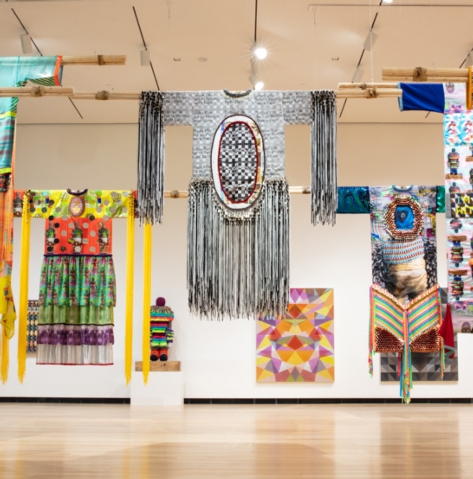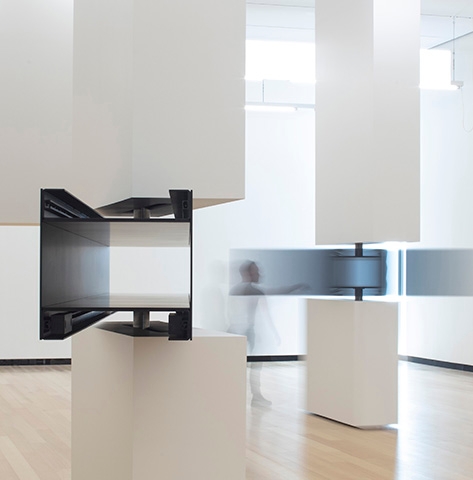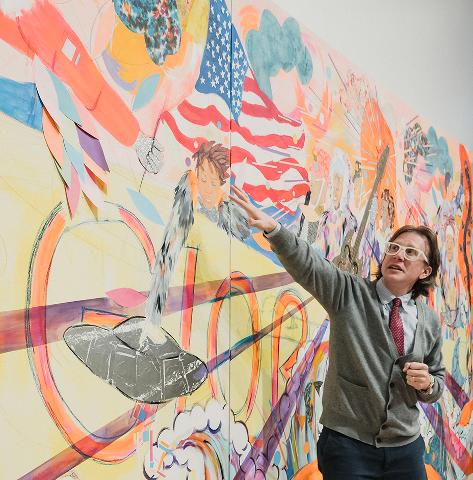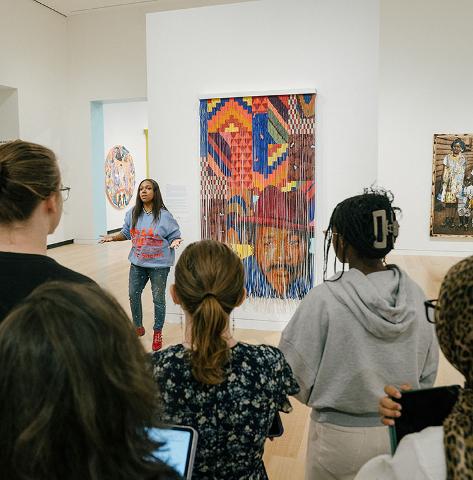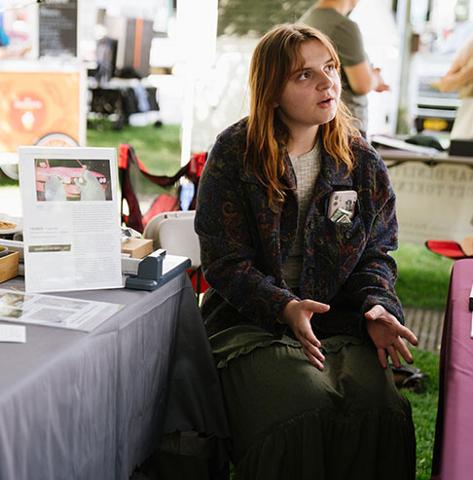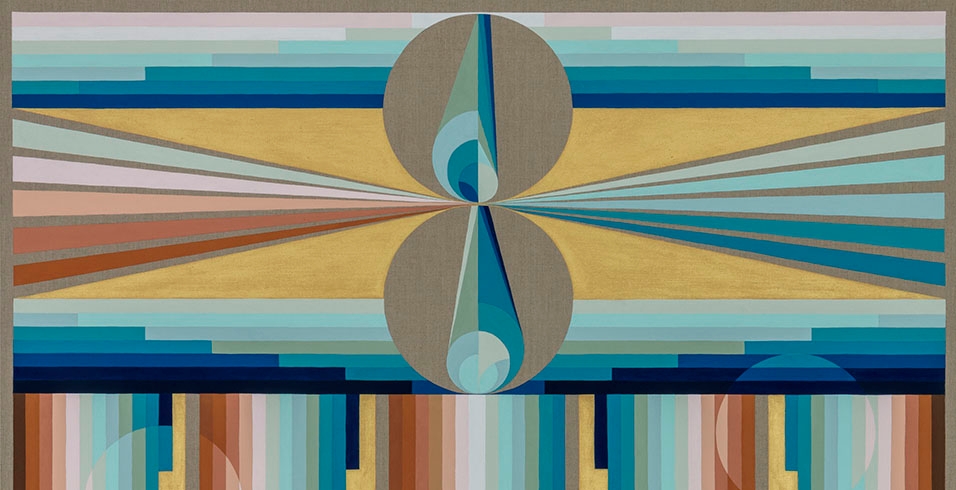
Since taking up the position of the Wellin’s Collections Curator in December 2020, I’ve been pleased to oversee the addition of many new works to the museum’s collection. Last year we made a number of exciting purchases and received some extraordinary gifts of art from donors, all of which join the over 7,500 objects that we already hold. It has been challenging to choose just five new works to highlight, but nevertheless here are a few of the wonderful pieces that entered the collection in 2021.
Cara Romero (Chemehuevi, born 1977)
Archival pigment print
50 5/8 × 43 15/16 in. (128.6 × 111.6 cm)
Purchase, William G. Roehrick '34 Art Acquisition and Preservation Fund
Naomi is one of two photographs from Cara Romero’s “First American Girl” series that we have purchased for the Wellin’s collection. With a wry nod to the popular American Girl doll brand in the title of the ongoing series, Romero collaborates with her sitters to create depictions of them as boxed “dolls,” complete with accessories. An enrolled citizen of the Chemehuevi Indian Tribe, Romero has commented, “I wanted to create dolls that reflect our many Native American cultures, beauty, and diversity as Native American women. Dolls that pay attention to all the details, historical accuracies, and accessories. Not just a “pan-Indian” look. Not what you find in a truck stop. Those dolls just never do us justice.”
Naomi is titled after the young woman depicted in the image, which was collaboratively produced by the photographer, the sitter, and her family. A member of the Northern Chumash Tribe, Naomi is shown wearing her traditional ceremonial dance regalia, made by her mother, a celebrated regalia maker. With this image, Romero simultaneously celebrates tradition and the modern Chumash woman. The hot pink “box” in which Naomi stands, with its geometric black and white border design, emphasizes her connection to Californian pop culture. Romero has stated that it is “a goal of mine to create thoughtful content that makes people think of preconceived notions of Native America, that challenges those perceptions, that creates multiple narratives, that all comes from a place of empowerment and celebration—a celebration of resistance.”

Ibrahim Said (Egyptian, born 1976)
Floating Vase 6, 2021
White Earthenware
20 3/4 × 10 1/2 × 9 1/2 in. (52.7 × 26.7 × 24.1 cm)
Purchase, William G. Roehrick ’34 Art Acquisition and Preservation Fund
Floating Vase 6 is currently on display in the Wellin’s Archive Hall, where it has captured the imagination of many visitors (and Safety Officers). While the vessel’s golden rabbit motif might initially catch the eye, the object’s extraordinary character only truly becomes clear once you get up close. Featuring a delicate, hand-carved, heavily perforated surface, the upper section of the ceramic vessel appears to float just above the bottom section – a seemingly impossible feat.
Virtuoso ceramic artist Ibrahim Said grew up in Fustat, a historic neighborhood in Cairo that is an international center for the production of commercial pottery and home to the Mosque of Amr ibn al-As, Africa’s first mosque, established in 641-642 CE. This combination of influences enabled Said to develop the technical skill and gain exposure to the ancient artforms that inspire his ceramic artworks. The rabbit motif and perforated surface of Floating Vase 6 are based on Said’s interest in, and research into, historic Islamic jug filters, traditionally found in the necks of drinking jars. Designed to strain out impurities found in Nile River water, these ceramic filters were only visible to the person drinking from the vessel. By making visible these formerly invisible designs, Said brings renewed life and appreciation to these ancient objects.

Howardena Pindell (American, born 1943)
Constellations, 2015
Open bite etching
30 × 22 in. (76.2 × 55.9 cm)
Gift of Aeon L. Cummings, Class of 1985
A significant figure in American art, Howardena Pindell is a multi-disciplinary artist, curator, and educator. In addition to her achievements as an artist, she was the first Black female curator to be hired at The Museum of Modern Art in New York City, and co-founded the A.I.R. Gallery, the first artist-directed gallery for women artists in the United States. For all these reasons, we are thrilled to have her work represented in the Wellin’s collection.
Pindell’s father was a mathematician and the artist has explored her interests in math and science alongside creating art, often expressing her wonder at what she has discovered in these fields through her artwork. Constellations incorporates the circle – a shape that often appears in Pindell’s work – with the artist’s memories of star charts, math notations, technical symbols, and a host of other references. Pindell has stated that the arrows and numbers that make up this circular printed image were “inspired by not only the cosmos but sky charts one gets in the centerfold of Astronomy magazine.” Moreover, the circular image variously relates to the artist’s experiences of looking through her microscope as a child, seeing pictures of the lines formed by particles that had collided in a Cyclotron in The Tao of Physics, and to an Astronomy course that she took where she was stunned to learn that the Earth revolves around the sun while also revolving at about 68,000 miles an hour.

Nate Lewis (American, born 1985)
Orchestra in the Valley, 2021
69 3/4 in. × 43 in. (177.2 × 109.2 cm)
Hand sculpted inkjet print, ink, frottage, graphite, colored pencil sticks
Purchase, William G. Roehrick '34 Art Acquisition and Preservation Fund
All of the works on this list are best experienced in person, but images really don’t do Nate Lewis’s Orchestra in the Valley justice. While visitors have many questions when encountering this piece, “what is it made from?” tends to be their first inquiry. Looking closely, viewers can make out that the sepia-toned area at the center top of the work is a blurred photographic image of hands, captured in motion. However, the rest of the artwork seems to be anything but a photographic image. Lewis has pricked, sliced, and carved the predominantly black inkjet print, creating areas of incredible texture and pattern, revealing the white paper beneath the surface (see, for example, the brilliant white foot at the bottom of the piece, where the artist has created a textured appearance similar to scarification). Lewis has also skillfully constructed several sections of the work to have a lenticular effect. Visitors discover vivid areas of color emerging as they move from left to right in front of the work – a surprising facet that can only really be experienced in person. The incredibly dynamic surface of Orchestra in the Valley is echoed by the energetic movement of the work’s subjects, the Black figures whose bodies emerge from the dark background’s swelling waves of silver graphite.

Eamon Ore-Giron (American, born 1973)
Infinite Regress CLIX, 2021
Mineral paint and flashe on linen
72 in. × 72 in. × 1 1/2 in. (182.9 × 182.9 × 3.8 cm)
Purchase, William G. Roehrick '34 Art Acquisition and Preservation Fund
Eamon Ore-Giron has drawn from a multiplicity of references to create his richly colored abstract geometric painting Infinite Regress CLIX. The painting is the 159th in the artist’s Infinite Regress series (“CLIX” is 159 in Roman numerals), all of which feature a similar visual language. For visitors who might be intimidated by the challenge of interpreting abstract art, be reassured: the artist intends viewers to heuristically discover meaning through their personal experience of his artwork.
Born in Tucson and now based in Los Angeles, Ore-Giron has Peruvian and Irish-American heritage, and identifies as Latino. He has lived in Mexico and Peru, as well as the United States, and his cross-cultural interests are visible in Infinite Regress CLIX, as well as across his practice as a whole. Ore-Giron has stated that his work “makes manifest a history of transnational exchange”, and challenges the idea that geometric abstraction is a tradition that originated in the West. In line with Ore-Giron’s emphasis on transnational exchange, and with knowledge of some of his various influences, Infinite Regress CLIX is currently on display at the Wellin alongside a selection of Mesoamerican and Andean objects. Viewers may note the painting’s relationship to ancient architectural forms (such as Inca temples), hieroglyphics, astral charts and the prevalent use of gold, among many other points of inspiration.
As noted above, a number of these objects are currently on display at the Wellin, while the others can be viewed upon request. You can check out all of our recent acquisitions via the collection page of the Wellin’s website, as well as see more of our collection holdings. We are also excited to delve into the collection for our upcoming exhibition, Dialogues Across Disciplines, which celebrates the Wellin’s 10th anniversary and opens in the fall.
The Wellin’s collection exists for the benefit of students, faculty, alumni, and the wider community. We encourage you to stop in and see what’s new!



